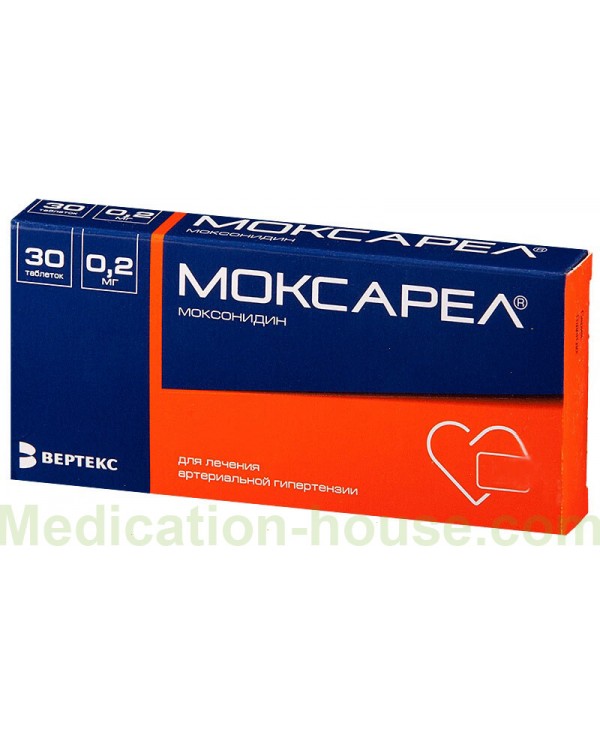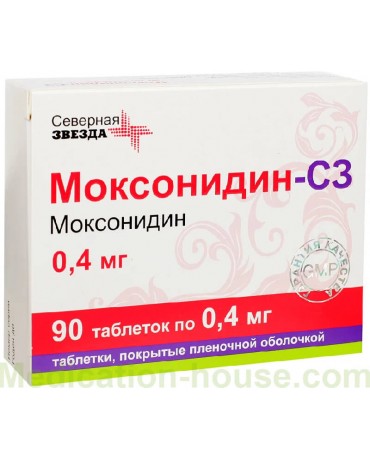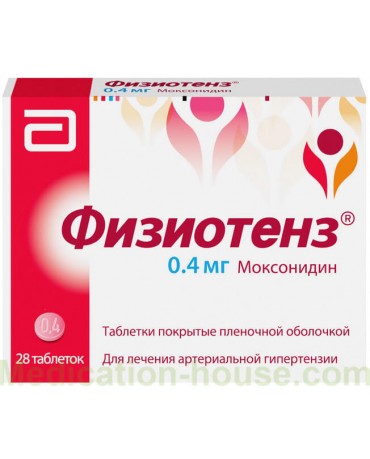Instruction for Moxarel
Reed more and buy Moxarel here
Moxarel is an antihypertensive drug.
Release form and composition
Moxarel is available in the form of film-coated tablets: almost white or white (0.2 mg each), pink (0.3 mg each) or yellow (0.4 mg each), round, biconvex, in cross section an almost white or white core stands out (in blisters: 10 pcs., in a cardboard box 1, 2 or 3 packages; 14 or 15 pcs., in a cardboard box 1, 2 or 4 packages; 30 pcs., in a cardboard box 1 or 2 packages).
1 tablet contains:
active substance: moxonidine - 0.2; 0.3 or 0.4 mg;
auxiliary components: colloidal silicon dioxide, lactose monohydrate, croscarmellose sodium, povidone K30, magnesium stearate, microcrystalline cellulose;
the composition of the film shell: macrogol 4000 (polyethylene glycol 4000), hypromellose, titanium dioxide, talc; 0.3 mg tablets - red iron oxide (iron oxide); tablets of 0.4 mg - iron oxide yellow (iron oxide).
Pharmacodynamics
Moxarel is an antihypertensive drug, the active substance of which is moxonidine, which has a central mechanism of action, selectively stimulating imidazoline-sensitive receptors in the rostral layer of the lateral ventricles of the brain, which are involved in tonic and reflex regulation of the sympathetic nervous system. The result of stimulation of imidazoline receptors is a decrease in peripheral sympathetic activity and blood pressure (BP).
Unlike other sympatholytic antihypertensive drugs, the likelihood of developing dryness of the oral mucosa and a sedative effect against the background of the use of moxonidine is very low.
Moxarel's action causes a decrease in systemic vascular resistance and blood pressure.
Moxonidine improves the insulin sensitivity index in patients with insulin resistance, obesity, and moderate hypertension.
Pharmacokinetics
The absolute bioavailability of moxonidine is approximately 88%. After oral administration, it is almost completely absorbed in the upper gastrointestinal tract. The time to reach the maximum plasma concentration (Tmax) is approximately 1 hour. Food intake has no effect on the pharmacokinetics of the drug.
Plasma protein binding - 7.2%.
The main metabolite of moxonidine is dehydrated moxonidine, its pharmacodynamic activity is 10%. The half-life of moxonidine reaches 2.5 hours, its metabolite - 5 hours.
More than 90% of moxonidine (including 78% unchanged, 13% in the form of dehydromoxonidine, 8% in the form of other metabolites) of the dose taken is excreted in the urine through the kidneys. Within 24 hours, less than 1% of the dose taken is excreted through the intestines.
In elderly patients, the pharmacokinetic parameters of moxonidine undergo some changes. This may be due to a decrease in metabolic rate and / or its higher bioavailability.
The elimination of Moxarel is largely interrelated with creatinine clearance (CC). With moderate renal failure with a CC of 30-60 ml / min, the half-life increases by about 1.5 times, with severe renal failure (CC less than 30 ml / min), the indicator is 3 times higher than with normal renal function. In hemodialysis patients with end-stage renal failure (CC less than 10 ml / min), the half-life is approximately 10 hours. And the equilibrium concentration of moxonidine in blood plasma is 2, 3 and 6 times higher, respectively, than in patients without renal dysfunction. Reception of multiple doses of moxonidine can lead to predictable accumulation of it in the body, the maximum concentration of moxonidine in the blood plasma in all groups of patients is 1.5–2 times higher. Therefore, in patients with functional impairment of the kidneys, the dosage of the drug should be selected individually.
During hemodialysis, moxonidine is excreted to an insignificant extent.
Pharmacokinetic studies in patients under 18 years of age have not been conducted, since Moxarel is not recommended for use in children.
Indications for use
According to the instructions, Moxarel is indicated for the treatment of arterial hypertension.
Contraindications
severe heart rhythm disturbances;
acute and chronic heart failure [III – IV functional class according to the classification of the New York Heart Association (NYHA)];
sick sinus syndrome;
atrioventricular (AV) block II – III degree;
bradycardia with a heart rate (HR) less than 50 beats per minute;
severe renal failure (CC less than 30 ml / min), including patients on hemodialysis;
concomitant therapy with tricyclic antidepressants;
syndrome of glucose-galactose malabsorption, lactase deficiency, lactose intolerance;
breastfeeding period;
advanced age over 75;
children and adolescents up to 18 years old;
hypersensitivity to the components of the drug.
Caution should be exercised when prescribing Moxarel tablets to patients with grade I AV block, severe coronary artery disease, chronic heart failure, severe coronary heart disease, unstable angina pectoris, impaired renal function (CC more than 30 ml / min), severe liver failure ( more than 9 points according to the Child-Pugh classification).
During pregnancy, the use of Moxarel is possible only in exceptional cases, when, according to the doctor's opinion, the expected effect of therapy is much higher than the potential risk to the fetus.
Instructions for the use: method and dosage
The tablets are taken orally, regardless of the diet.
Recommended dosage: initial dose - 0.2 mg per day. To achieve the desired therapeutic effect, the dose can be increased. A single dose should not exceed 0.4 mg. The maximum daily dose is 0.6 mg, which, if prescribed, is divided into 2 doses.
The initial dose of Moxarel for moderate or severe renal failure and for patients on hemodialysis is prescribed in the amount of 0.2 mg per day. With good tolerance, it can be increased as needed to 0.4 mg per day.
Side effects
on the part of the cardiovascular system: infrequently - orthostatic hypotension, marked lowering of blood pressure, bradycardia;
from the central nervous system: often - headache, vertigo (dizziness), drowsiness; infrequently - fainting;
from the gastrointestinal tract: very often - dryness of the oral mucosa; often - dyspepsia, diarrhea, nausea, vomiting;
mental disorders: often - insomnia; infrequently - nervousness;
dermatological reactions: often - rash, pruritus; infrequently - angioedema;
on the part of the connective and musculoskeletal tissue: often - back pain; infrequently - pain in the neck;
from the organ of hearing and labyrinth disorders: infrequently - ringing in the ears;
other reactions: often - asthenia; infrequently - peripheral edema.
Overdose
Symptoms: dryness of the oral mucosa, vomiting, pain in the epigastric region, drowsiness, marked decrease in blood pressure, sedation, headache, dizziness, asthenia, increased fatigue, respiratory depression, impaired consciousness, bradycardia, possibly tachycardia, short-term increase in blood pressure, hyperglycemia ...
Treatment: since there is no specific antidote for the drug, then with a pronounced decrease in blood pressure, it is recommended to administer dopamine and take measures to restore the volume of circulating blood in the patient. To stop bradycardia, atropine is used. The use of alpha-adrenergic receptor antagonists has been shown, the action of which, in case of an overdose of moxonidine, can reduce or eliminate paradoxical hypertensive effects. In severe forms of overdose, it is necessary to prevent respiratory depression, carefully monitoring impairment of consciousness. The use of hemodialysis only slightly promotes the elimination of moxonidine.
Special instructions
It is recommended to discontinue the drug by gradually reducing the dose of moxonidine taken over two weeks. If it is necessary to cancel the simultaneously taken beta-blocker and Moxarel, then first stop taking the beta-blocker and only after a few days of Moxonidine.
The use of tablets should be accompanied by regular monitoring of blood pressure, heart rate, and electrocardiography.
During the period of taking Moxarel, alcohol is contraindicated.
Influence on the ability to drive vehicles and complex mechanisms
It is recommended to exercise caution when patients perform potentially hazardous activities requiring increased attention and high speed of psychomotor reactions, including driving and working with complex mechanisms. This is due to the possible occurrence of dizziness or drowsiness during therapy.
Application during pregnancy and lactation
With caution, only after a thorough assessment of the benefits and risks, Moxarel should be prescribed during gestation, due to the lack of clinical data on the experience of its use in pregnant women. You can start taking pills only if the expected therapeutic effect for the mother outweighs the potential threat to the fetus.
The use of moxonidine during breastfeeding is contraindicated. If necessary, taking Moxarel during lactation, breastfeeding should be discontinued.
Childhood use
The use of Moxarel under the age of 18 is contraindicated, since the safety and efficacy of using moxonidine in children and adolescents has not been established.
With impaired renal function
The use of Moxarel is contraindicated in severe renal failure with CC less than 30 ml / min, including patients on hemodialysis.
The drug should be taken with caution in case of impaired renal function with a CC of more than 30 ml / min.
The starting dose for patients with moderate or severe renal impairment, including those on hemodialysis, is 0.2 mg per day. With good tolerance, the dose can be increased as needed to 0.4 mg per day.
For violations of liver function
Caution should be exercised when prescribing Moxarel to patients with severe (more than 9 points according to the Child-Pugh classification) hepatic insufficiency.
Use in the elderly
The use of Moxarel over the age of 75 is contraindicated.
Drug interactions
With the simultaneous use of Moxarel:
tricyclic antidepressants: reduce the hypotensive effect of the drug;
other drugs with hypotensive action: cause an additive effect;
tranquilizers, ethanol, tricyclic antidepressants, hypnotics and sedatives: may increase their effect;
beta-blockers: cause an increase in bradycardia, the severity of inotropic or dromotropic action;
benzodiazepine derivatives: may enhance their sedative effect;
drugs released by tubular secretion: may interact with moxonidine;
moclobemide: does not cause pharmacodynamic interaction with the drug;
lorazepam: Possibly moderate improvement in impaired cognitive function.
Terms and conditions of storage
Keep out of the reach of children.
Store at temperatures up to 25 ° C in a dark place.
Shelf life is 3 years.
Reviews about Moxarel
The few reviews about Moxarel are mostly positive. Regular intake of tablets provides a sustainable therapeutic effect.
Terms of sell
You can buy Moxarel without a prescription.



